Trekking Destinations > Everest > Basic information
Retrace the footsteps of Edmund Hillary and Tenzing Norgay. Enjoy the hospitality of Sherpa village life. Brush against the majesty of Mt. Everest. These are only a few of the experiences that await you in the fabled Solu-Khumbu region of Nepal.
Basic Information about Khumbu Region |
Religiously Protected Forests of Khumbu region Religiously protected forests cover greater area than a single water spring or cave, and provide home for a variety of species. Phortse, a highly religious village off the main trekking route, but still in the heart of Khumbu, has the strictest, most traditional forms of forest management of any of the villages in Khumbu. The forest immediately around the village is preserved because of the dictum of an ancient lama, who performed a ceremony in the forest, sprinkling around blood from his own scalp and requiring that the villagers preserve the forest into posterity, or face misfortune. To this day, the forest is protected, and people may collect only leaf litter from it. Several gompas, including those at Kerok, Khumjung, Tengboche, Pangboche, Debuche and Namche have notable forests around them. The practice of maintaining a forest around the Gompa is thought to extend back to the time of Lama Sangwa Dorji, who is said to have pulled out some of his hair and thrown it on the ground, causing juniper trees to grow up around Pangboche Gompa. The Gompa forest, established by Lam Sangwa Dorji, was then emulated at other gompas. Many people believe that the Buddhism opposes cutting trees. However, for pragmatic reasons, they are not always able to follow this belief. Several reasons are given for not cutting trees: • A tree is like a god, or home to a god • A tree requires many years to grow, "like a child," cutting a tree is a sin equal to killing a person. • As mentioned previously, individual trees may also be protected by the belief that they are home to a spirit called a Lu. • Some individual trees, such as those believed to be home of a Lu, or believed to have been planted by one of the great lamas, gain great size as they are spared the axe. • The larger and older a tree becomes the greater value of affiliation it may carry for villagers who have lived with the tree throughout their lifetimes. As the tree increases in affiliative value, it may become more likely that its size and longevity are attributed to spiritual power. • These Gompa forests are protected by the instructions of the lamas and the belief that Buddhism opposes the cutting of trees. |
Religiously Protected Mountains of Khumbu Region Though it's the highest peak in the world, Everest is not an especially sacred mountain. It is home to Miyo Lang Sang Ma, whose name is shortened to Chomolungma, the Tibetan name for the mountain. Miyo Lang Sang Ma, one of the Five Sisters of Long Life, is the goddess who provides food. Another of the sisters, Tashi Tserinma, resides on Gauri Shankar in Rolwaling. Khumbila or Khumbu Yul Lha, Khumbu Country's God, is the central sacred peak of Khumbu, standing between Namche, Khumjung and Thame. Khumbila has never been climbed; one attempt prior to the 1980's ended when climbers were killed in an avalanche, and there have been no subsequent attempts. Khumbila is said to be a powerful god, and on old one. The prayers for Khumbila are believed to date back to the time when the ancestors of the Sherpas were still in Tibet (more than 500 years ago). Khumbila is said to have been subdued and converted to Buddhism by Guru Rimpoche, the 8th century saint, considered to be a second Buddha, who spread Buddhism throughout the Himalaya . In fact, Guru Rimpoche is said to have spent some time meditating in a cave above Khunde, perhaps on the mountain Khumbila itself. This connection between Guru Rimpoche and Khumbila surely adds to the sacredness of the latter. Every house has prayer flags on bamboo wands to honor Khumbila. The flags are changed three times per year. At Dumji, a summertime festival that celebrates the Sherpas' connection to their home and each other, and honors Guru Rimpoche, Khumbila is welcomed on the first day the festival. The repetition and re-inscription of the Sherpas' association with and dependence upon Khumbila through the rituals offerings maintains the power of this reciprocal relationship, thereby maintaining the protection of the mountain itself. |
Religious Structure of Khumbu Region Mani (Mani Thungkyur) A Mani Thungkyur is a big prayer wheel, which contains many religious books and has sacred invocation of prayers. It average size is 2m high and 1.5m in diameter. Some villages have a separate communal building for Mani-Thungkyur known as (Mani Lhang), which can be connected with the main 'Gondas" or in a private house. Lhang A Lhang is a private chapel built in association with the main house. Access is gained from within the house. The walls are decorated with mural paintings and some statues and books. Chorten (Stupa) A Chorten is a shrine usually built of stone with Buddha eyes on four sides guarding against evil spirits that can enter the village. These are generally found at the entrance to a village, along with the Mani walls or a kani. It contains relics of an important lama as well as prayer books. Kani At the entrance to a village settlement or to a monastery, there is always a small gateway, or Kani, with its ceiling and walls usually painted with religious figures. These entrance gates and chortens stop the bad spirits that can follow a person from entering the village. Mani Walls Manis are stones engraved with the sacred invocation " Om Mani Padme Hum" which are either built in to the walls or piled around the Chorten. People pass these walls on the right side to gain sonam (Merit). Gompas and Gondas (Monastery building) A Gompa can be a common village property or an institution. The lama in charge of managing them is usually a Reincarnate lama. A Gompa is also a gathering place for the whole community especially in festivals such as Nyingne and Dumji. |
Religious Festivals in Khumbu Region Dumji Dumji is a great festival in which the whole community takes part. It has been in practice for more than 300 years during the monsoon season. The local representatives provide food and drink for the whole community for 5 days. The responsibility for this festival falls on every household once or twice in a lifetime depending on the number of houses in each village. One this occasion rich and poor join the celebration on equal terms. Monks from Tengboche Gompa are invited to recite the ceremony. The main purpose of Dumji is two-fold: it is both a request to various gods' power to subdue demonic enemies of the village and a celebration of the anniversary of the death of the patron saint Lama Sanga Dorji. Nyingne Nyingne is performed at the end of May or early June in village Gompa. The main purpose of this festival is to cleanse the worshippers of sin and to help them obtain more sonam (merit). This rite requires a lama, generally the Head Lama from Tengboche, to oversee it. The participants recite prayers along with the lama on the first day. The second day, everyone fasts and they do not speak to one another. Finally, one the third day after obtaining a blessing from the lama, they depart back to their own houses. Kangyur Kangyur along with Tangyur is known as the bible of Tibetan Buddhism, translated from the Sanskrit edition of Tripitaka to Tibetan presumably in the 13th century by Tibetan Guru Rimpoche. It records the sayings of the Buddha. The Kangyur contains 108 volumes comprising ethical works ascribed to Buddha. Kangyur is recited to ward off mishaps, misfortunes, calamities, violence, plague, wars, and natural disasters and bring peace, prosperity and harmony among humans. By the virtue of Kangyur recitation, a person is believed to add years to his/her life and can forever live in peace and prosperity devoid of sins. Mani Rimdu The first celebration of Mani Rimdu at Tengboche monastery probably took place sometime in 1930. The festival originated in Rongbuk Monastery in Tibet . Mani Rimdu is a prayer ceremony where the monks put on masks representing divine spectators come from many villages to gain sonam from the Head Lama's blessings and to make corn and grain contributions to the monk community. Chirim A village rite known as Chirim is performed in the village's Gompa twice a year in April and October with a purpose to drive off evil spirits, which may threaten the community. It involves local lamas officiating and making Torma (figure made out of dough) resembling deities and evil spirits. Two families appointed by rotation from all the households organize the rite. O-Sho Unlike the Chirim, O-sho is celebrated one time with a procession encircling the whole village to provide supernatural protection for the newly sown crop at the beginning of the agricultural season. During the procession, four tormas resembling the 4 guardians of the village are placed in the 4 corners of the village land. |
Sherpa People in the Khumbu Region Khumbu is the homeland of the Sherpa people. According to researchers, Sherpas appear to have left their original homeland, the Tibetan Province of Salmo Gang, and crossed the Nangpa La (Pass 5716m) into Nepal in the late 1400s or early 1500s. The Sherpa people follow the Nyingmapa sect of Tibetan Buddhism, which is an outgrowth of the Mahayana tradition; Gompas are the centers for practicing religious rites where various festivals are performed. Throughout the year, Sherpas carefully worship the mountain god Khumbu Yul Lha. For devotion, they hang prayer flags on their roofs and make offerings. Good example of this religious practice can be seen during the Dumji festival held in June each year, where requests are made to the god for support against evil forces. |
Myth of the Himalayas : Yeti in Khumbu region The yeti or abominable snowman is thought to live in the high Himalayas . The Sherpas distinguish three different types of yeti. Drema or Telma , the messenger of calamities; Chuti, which preys on goats, sheep and yaks; and Mite or Midre which also attacks animals and sometimes men. Nobody has even seen a Yeti, only the findings of mysterious footprints in the snow and several incidents of yaks' killings support the legend. |
Social Festivals in Khumbu Region Losar (New Year) This festival usually falls at the end of January or early February. At this time, the ground is frozen, and often covered in snow. The main activities include spinning, weaving, feeding livestock and repair jobs. On this occasion, every household worships its clan god, throws away a year's dirt from the house and uses flour to decorate the house's panels with good luck signs for the coming year. Following this, children celebrate with new clothing and feasting. Feasting may go on for weeks depending on the number of household's participating. Yarchang Yarchang is a summer rite to secure the welfare of the herds that takes place in the summer pastures higher up in the valleys. Here every household worships their own clan and local mountain god such as Khumbi-yul-lha. In the first day, all the families in the settlement area put prayer flags on their houses and gather in front of an altar. Like Osho and Chirim, the locals make torma resembling clan and local mountain gods. These tormas are distributed among the families after the recitation. Phangni Phangni is a social festival celebrated during the month of July. Although the origin of this festival is not definite, it is presumed that it was feted since the 3rd century. Besides tending the livestock, the month of July is pretty free of chores and a leisure time for the fun loving and high spirited Sherpas who then engage in a communal entertainment and amusement which is known as Phangni. Different groups organize Phangni that last up to 4 days. During these days, all the necessary items required for the festival is collected communally. People eat, drink, dance and jest around in merry the entire days. At the end of the festival, responsibility is specified on a rotational basis for the celebration of Phangni for the subsequent year. |
Cultural Tips to Khumbu Region • Walk on the left side of Mani walls as you pass them. This practice signifies that you respect the Buddhist tradition and turn prayer wheels in a clockwise direction. Never sit on Mani stones or stupa. • Don't litter local springs as it is believed that this will anger the water god, Lu. • Don't put dirty items and food scraps such as meat in he fires of Sherpa hearths, as it is believed that offensive odors from such pollution angers the local mountain gods. • Always make a small contribution to any temple or monastery that you visit. This is a time honored indigenous tradition. • Ask permission to take photographs of people, and if you do extensive photography, it is polite give the subjects a small gift. • Don't ask a Sherpa to kill an animal for you to simply eat meat. This is forbidden in Khumbu both by village custom and by the Buddhism religion. • A Khata (white/yellow scarf) is used to welcome, bid farewell, and to show gratitude. It is traditional to put the scarf round men's neck starting from the right hand and women from the left. Don't put scarves around the neck of a lama simply offer it to his hand. • Don't give things to begging children, however, please do give as generously as possible to a begging monk or nun as this is a time honored religious tradition. • The seat next to the fire hearth in a traditional Sherpa home is reserved for the main person of the family whether alive or death. Therefore, please do not sit there. • Don't forget to smile and try to remember the Sherpa word for thank you, which is thuche thuche This informations are based on the Brochure "Sacred Sites of Khumbu Region " published by the THE MOUNTAIN INSTITUTE, Sacred sites Trails Project. www.mountain.org |
- Everest Region
- Annapurna Region
- Langtang Region
- Around Kathmandu
- Adventure Trekking
- Peak Climbing
- Bicycle Tour
- Sight-Seeing Excursions
- Custom Itineraries
- Information About AMS
- Clothing and Gear
- Personal Security in Nepal
- Nepal Fact Sheet
- Trekking Grade in Nepal.
- Trekking Rules and Regulation
- Why Himalayan Humanity ?
Images of the
Everest Region
©
2003, Rich Rawling
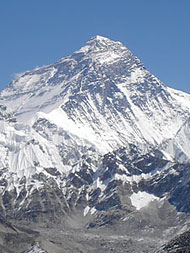
Everest from north of Gokyo
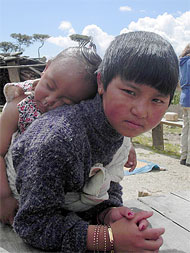
Sisters in the Sherpa village of Trakshindu La

Buhddist chorten through a tea house window
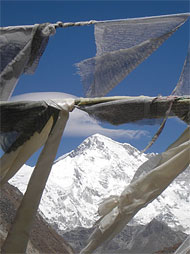
Cho Oyu and faded Buhddist prayer flags

Terraced fields along the trail from Jir
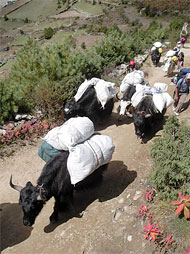
Dzopkyos carry loads above Namche Bazaar
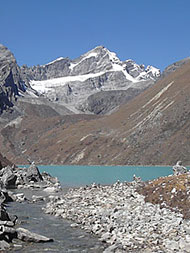
Gokyo Lake
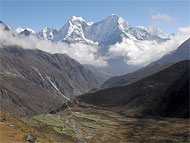
Looking back to Thamserku from above Machermo
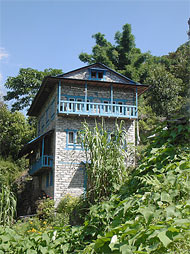
Family house along the trail up the Dudh Kosi